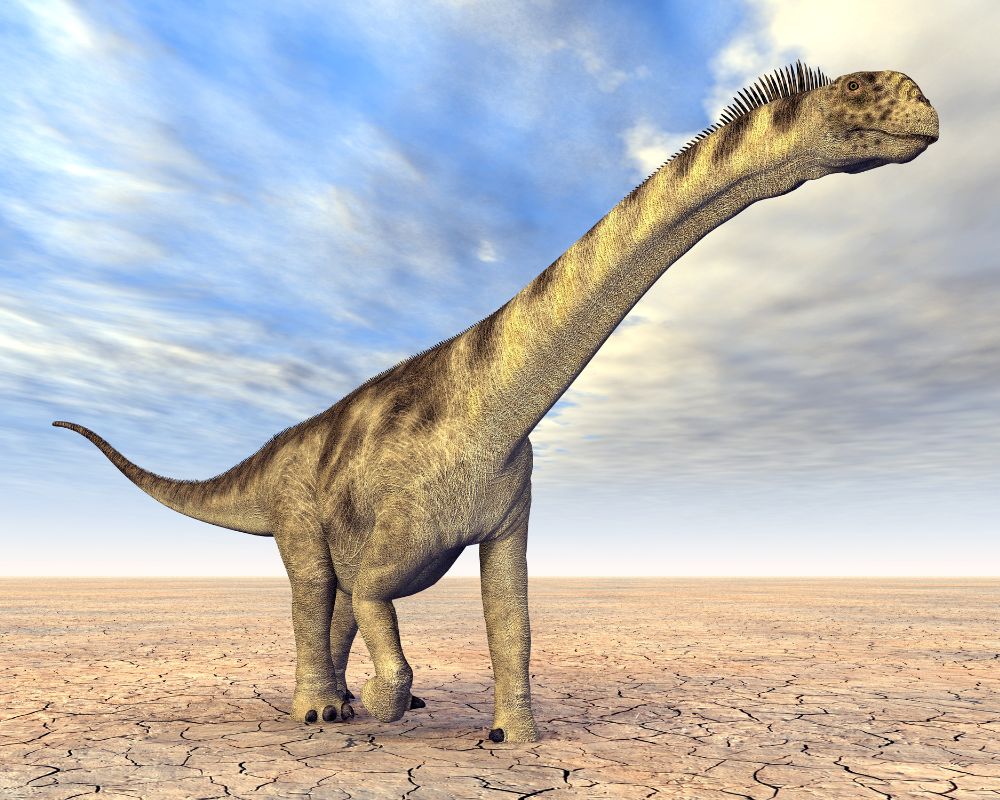The Camarasaurus, or Chambered Lizard, was a large sauropod that roamed North America in groups during the late Jurassic period. It was unusual because it had hollow vertebrae in its neck and back that helped it move quickly to reach the tall branches in nearby trees. While it was a giant dinosaur (around the size of a house), it still had to watch for hungry predators, like the Allosaurus. But more on that a little later.
Table of Contents
Some Quick Facts about the Camarasaurus

| Name | Camarasaurus (meaning “chambered lizard”) |
| Type of dinosaur | Sauropod, Saurischia, Sauropodomorpha |
| Territory | Grasslands, North America |
| Size | Large, 75 feet long, 23 feet tall |
| Color | Brownish |
| Interesting Characteristics | Small, square-shaped skull, holes in its vertebrae |
| Diet | Plants and leaves of tall trees |
| Major Threats | Allosaurus |
The Camarasaurs was a large sauropod that walked on all fours and had a very long neck for eating the leaves of tall trees. These Jurassic-age dinosaurs were some of the most common dinosaurs in North America and often traveled in large groups like elephants. Keep reading to learn what made the Camarasaurs so special!
What Does Camarasaurus Mean?
Camarasaurus translates to a chambered lizard. The Greek word kamara translates to vaulted chamber, saurus means lizard. Therefore, it means chambered lizard. But what does that mean, exactly?
The Camarasaurus is unique because the fossilized vertebrae were hollow and contained tiny chambers. The hollow bones in its long neck made it lightweight (like a bird) but very strong. It used its long and powerful neck to reach the tippy tops of trees for a little snack. The hollow bones made it much easier to move its neck and reach the higher branches of a tasty tree.
What is the Average Size of a Camarasaurus?

The Camarasaurus was a big dino but wasn’t the largest sauropod in the Jurassic period. That title belongs to the Apatosaurus, Brachiosaurus, and Diplodocus. On average, the Camarasaurus measured to be 75 feet long, 23 feet tall, and weighed a whopping 47 tons.
Let’s put those measurements into perspective. If Camarasaurs were 23 feet tall, that’s about the same size as two giraffes stacked on each other. They also weighed about the same as your house!
How Many Camarasaurus Can Live Together?
The discovery of various fossil records not only told us a lot about what this dino looked like but also that the Camarasaurus was a social dinosaur, similar to the Liliensternus.
These peaceful herbivores were never alone and were the most common sauropod in the Jurassic period. They often traveled together in groups of between two and seven dinosaurs. They also lived in what we’ll call pre-historic neighborhoods consisting of over 20 Camarasauruses in a single location.
What Habitat Did the Camarasaurus Live In?
Fossils of the Camarasaurus are primarily found in Colorado, New Mexico, Utah, and Wyoming. They preferred the perfect area with plenty of wetlands for a drink of water and lush, tropical plant life to eat.
They lived alongside riverbanks and on the edges of forests that provided more than enough to eat for these herbivores. Unlike other dinos of the Jurassic age, the fossils of the Camarasausus are only found in some areas of North America.
Where Was the Camarasaurus Found?
The first fossil evidence of the Camarasaurs was discovered in 1877 in the Morrison Formation and the historic Carnegie Quarry by Oramel Willian Lucas and Edward Drinker Cope. The very first Camarasaurus fossils found were its unique and hollow vertebrae.
Many fossils of this dominant North American dino are displayed at the Cleveland-Lloyd Dinosaur Quarry and the Dinosaur National Monument in Utah. These findings showed that the Camarasaurus was one of the most common North American dinos 150 million years ago.
Initial findings of the fossils did not recreate a single skeleton but a mish-mash of various Camarasauruses. Using the different fossil remains, paleontologists could compose a picture of precisely what this Jurassic dinosaur looked like. And it was enormous!
Do You Want to Join an Allosaurus Feast?
These giant docile herbivores were an epic meal for hungry theropods, especially the Allosaurus. A specimen of Camarasaurs at The Dinosaur National Monument shows the teeth marking of an Allosaurus in the camarasaurus pelvis. If you want to check out this exceptional specimen of Camarasaurus, you can see it in person at The Dinosaur National Monument.

